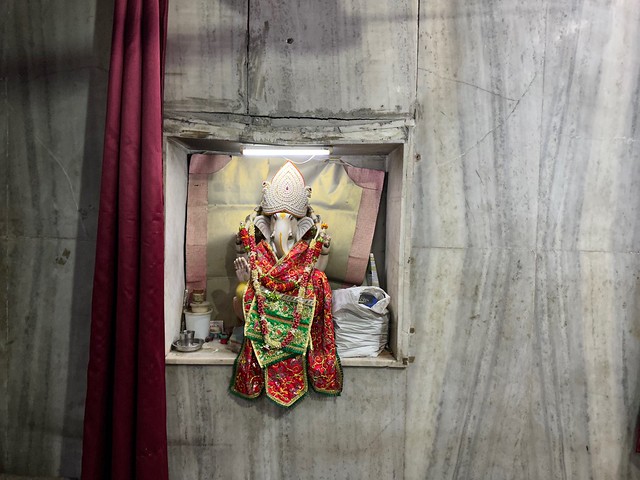
City Faith – Bankey Bihari Mandir, Inder Walli Galli

House of faith.
[Text and photos by Mayank Austen Soofi]
The lady in blue sari is walking down the lane of Inder Walli Galli, here in Old Delhi. At each step she pauses and takes a deep breath. She stops in front of a building of old-fashioned lakhori bricks, walks to the wooden door, and turns the key in the lock. The door opens, creakingly. Pitch darkness within.
She turns on the lights. Brass bells materialise. This turns out to be a temple.
Bankey Bihari Mandir “is more than a hundred years old,” she mutters, pulling apart the curtain of the central shrine. “Bhagwan Kishenji” comes into view. His sculpted face is black, his lips are deep red, and he is in a green silk-like fabric bordered with a red sequinned chunni. The large crown is of cardboard adorned with white pearls. Tiny figures of gau (cow) and her bachhra (calf) are installed on either side of the feet. “Kishenji used to herd gau by the Yamuna in Mathura,” the lady says, explaining the bovine presence.
At this hour, the temple is immersed in silence. The sounds coming from outside —of scooter horns, of children playing and shouting—have the aloofness of a distant echo. Showing a grandmotherly affection, the woman opens up—“I’m Sheela Devi, sattar ke upar (above 70). My husband was a priest here. He died many years ago. My son then took over the duties; he also has a job in a private company. I look after the mandir in the morning and in the evening. It remains closed in the afternoon so that gods can rest.”
Sheela Devi walks to the temple’s other shrines that are lined along its marble walls. She unveils each by pulling apart its curtain. The temple is soon filled with “Ganeshji, Durga Mata, Hanuman ji,” and with one more Kishenji, this time he is with his consort, “Radhaji.” The only curious object in the temple is a metal amirah. “It has the poshak (dresses) of the gods,” Sheela Devi says, sitting down in a corner chair. She begins to make cotton wicks that will be used to light earthen lamps in the evening.
Now a lady enters. Madhubala settles on a low moora, beside Sheela Devi. Both women quietly gaze upon the floor tiles patterned after a carpet. Soon, they start to chat about the approaching winter, their families, and the news about people living in nearby streets (recently somebody’s “jawan ladka” died).
The temple opens daily from 6am to 11.30am and from 4.30pm to 8pm.
Kirshna’s world
1.
2.
3.
4.
5.
6.
7.
8.
9.
10.
11.
12.
13.
14.
15.
16.
17.
18.



















Dear Mr Mayank Austen
At the outset, may I state that I like your website and visit it often. Please take this comment as a request and not as a moan.
Please consider using a bigger typeface with a darker font: thin of ageing eyes struggling with the tiny font, grey against white. Larger typeface, black against white, would be so much more legible.
Thank you for considering this suggestion.
With best wishes